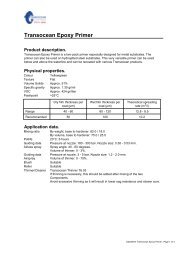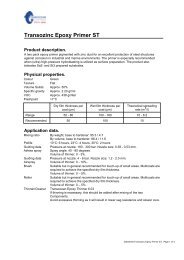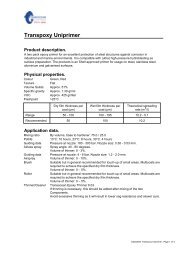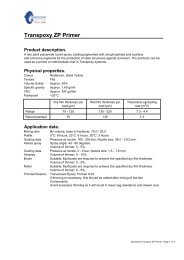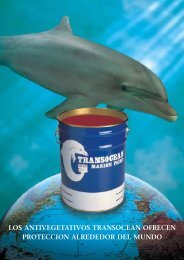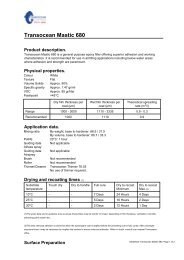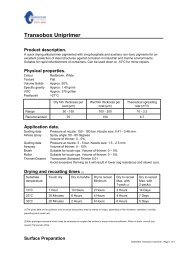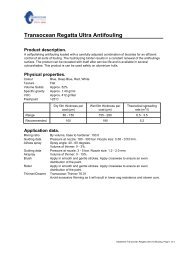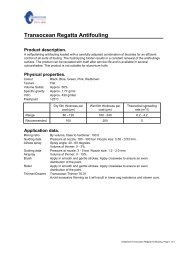brochure jachten eng 2005 - Transocean Coatings
brochure jachten eng 2005 - Transocean Coatings
brochure jachten eng 2005 - Transocean Coatings
- No tags were found...
You also want an ePaper? Increase the reach of your titles
YUMPU automatically turns print PDFs into web optimized ePapers that Google loves.
THE ULTIMATE WAYTO PROTECT PLEASURE
<strong>Transocean</strong> Coating SystemsCombined str<strong>eng</strong>thin protection!
The World of <strong>Transocean</strong>Across the world, <strong>Transocean</strong><strong>Coatings</strong> Association is active in themanufacture and supply of antifoulings,anticorrosives and othercoatings for ships, off-shore structures,industrial installations andpleasure crafts. Extensive researchand development work has provided<strong>Transocean</strong> with a series of productswhich professionals acknowledgeto be complete and of high quality.<strong>Transocean</strong> <strong>Coatings</strong> Association hasa network of manufacturers, spreadover all the continents, producing itsrange of products. Manufacturingtakes place using stringent formulations.Whether a product is suppliedin Europe, Asia, North or SouthAmerica, in Africa or Australia, thequality is identical.At any shore therefore, whereverin the world, you can rely on<strong>Transocean</strong> <strong>Coatings</strong> Association.And local service assures quickdelivery of factory-fresh productsat competitive prices.That’s unique!
Keeping your boat inexcellent conditionWhy use paints?Pleasure crafts are made out ofBeside the content of the barrier coat,the thickness of these barrier coats isof equal importance.different materials; metal (steel,aluminium), wood or Glassfibre reinforcedpolyester (GRP). Left unpainted,marine conditions will deterioratethese materials; metals will corrode,GRP can suffer from osmosis andmarine organisms can attack Wood.Therefore using paints is anefficient method to protect yourpleasure craft. Besides offeringHow much paint to apply?The minimum thickness of thedry film for surfaces below the waterlineis 400-450 microns for the entirescheme. For surfaces above the waterline,250-300 microns is sufficient.It is very important that these minimumthicknesses are respected.protection, coating systems have adecorative function too although forsome areas the emphasis is more onthe protective component such asantifoulings and ballast tanks.What about maintenance?The final step is to apply thefinish or topcoat. The topcoat givesWhich paint first?Coating systems can be dividedinto 3 groups of paints according totheir function in the coating system.Primers have good adhesion tothe substrate and provide a solid basefor recoating with other paints.After the primer, intermediate orthe required colour and gloss andprovides protection against variousinfluences such as sunlight, weatherand abrasive impact. It may also givespecific protective properties (such asthe antifouling onto the submergedareas). The finish must be regularlyrenewed to maintain the boat permanentlyin good condition.From time to time it is advised toremove the total paint system as theyearly maintenance results in a buildupof layers. Too thick layers notonly increases the weight of the boatbut the increased internal stress canalso lead to delamination of the totalcoating system.barrier coats are applied in order toenhance the overall protection andto provide a good intercoat adhesion.Barrier coats contain pigments,which reduce moisture penetrationand decrease oxygen permeability.
Maintenance made easywith <strong>Transocean</strong> PaintsWhen repainting your boat, the 7 Prior to application always readfollowing 10 steps apply to all boattypes whether made out of metal,wood or GRP.instructions on product data sheetfirst. After opening the can, ensurethat the paint is mixed to an even1 After lifting the boat, wash with consistency and colour. When usinghigh-pressure fresh water in order toremove any fouling, salts and dirt.two-pack paints, mix the two partsseparately prior to mixing both parts2 Degrease only areas that are together.affected by mineral oils by using a 8 When you are preparing a twopacksponge soaked in a suitable detergentand rinse with fresh water again. paint, note how much paintyou will be able to use before it3 Remove all old paint system that becomes unusable. The paints pot lifeis delaminating or not adhering well. is given on the product datasheetsTen points to rememberIf this involves large-scale scraping,use mechanical methods such assanding discs or blasting or by usinga paint stripper.and typically measured at a temperatureof 20°C. If you are working at ahigher temperature, you must reducethis time by around 20% for each4Clean and wash down all dustadditional 5°C. Stir the paint fromand debris with fresh water.When sanding intact paint layersuse 80-grade sandpaper for the hull.Use wet sandpaper especially whenpreparing an old antifouling layerto minimise the amount of airbornedust. For above waterline areas use240 – 320 grade sandpaper.Before starting to paint, removeall dust by washing with copiousamount of fresh water and allowdrying prior to painting.time to time in its container duringapplication and keep it at a lowtemperature to extend its applicationtime, at the same time avoidingprolonged exposure to sunlight.9 Do not paint in strong winds,during mist or in full sunlight.If necessary, make shaded areas usingtarpaulins.10 Finally, basic safety and hygienerules must be obeyed whenever youare using paint. Carefully read the5Mask the edges of the area to besafety instructions given on productpainted and remember to remove thetape immediately after the applicationof each coat, especially when youare using two-pack paints.and safety datasheets.Of course, your local <strong>Transocean</strong>representative will be more thanhappy to assist you in getting the6best results. Alternatively, checkRemember to plan the applicationof the whole paint system properly.Especially observe temperatureand weather forecast as well aswww.transocean-coatings.com forthe latest news, advices and solutionsfor any problem you may experience.recoating intervals of the paints to beused.
Glassfibre reinforced polyester (GRP)How to prevent osmosisGRP is the most popular materialfor hull construction today becauseof its versatile use and its pleasant,shiny appearance. Usually the gelcoatbegins to loose its luster and shineafter two or three years; so that thetopsides in particular become chalkyor crazed.When this happens, it is abouttime to start repainting.The gelcoat should be degreasedthoroughly with <strong>Transocean</strong> Gelcleanto eliminate traces of wax, paraffinand other contaminants. Highpressurewash with fresh water andallow thorough drying. Disc abradeto an even, matt finish. Remove dustand debris prior to painting.The system box gives our recommendationfor a full refurbishmentand for touch-up of spot repairs.The osmosis process starts whenwater penetrates in the gelcoat andreacts with substances in the hull.This will even attract more waterresulting in an increase in volumethat finally shows itself at thesurface in the form of blisters.Painting scheme for GRPIn case of painting over an intactepoxy protective system, apply1-2 coats <strong>Transocean</strong> Sealer priorto recoating with an appropriate<strong>Transocean</strong> antifouling system.2 layers <strong>Transocean</strong> PU finish2 layers <strong>Transocean</strong> Antifouling1 layer <strong>Transocean</strong> Sealer<strong>Transocean</strong> BarrierkoteUnderwater hull area: 2-3 layersAbove waterline area: 1-2 layersRepair of dents, holes etc. with <strong>Transocean</strong>Filler or <strong>Transocean</strong> MasticHowever, not all bubbles are theresult of osmosis. If the blisters arefilled with liquid and have an acidicsmell, osmosis is very likely. In caseblisters do not contain fluids but arethe result of air bubbles, repairingis relatively easy by just sanding andpriming.In case your boat shows signs ofosmosis contact your nearest<strong>Transocean</strong> dealer to get adequateadvice on the best procedure totreat the problem.Of course it is always better toprevent than to cure and therefore<strong>Transocean</strong> has developed specializedproducts such as <strong>Transocean</strong>Hydrostop or <strong>Transocean</strong> Guard thatforms a protective layer around thegelcoat. Before application, ensurethe hull has dried thoroughly bymeasuring the moisture content inthe hull since any remainingmoisture may lead to blistering ordelamination of the coating.
WoodThe system boxes gives twothe wood fibers. Alternatively, thewood can be permanently protectedagainst water penetration by using<strong>Transocean</strong> Resin System.The protection of <strong>Transocean</strong>Resin System can be reinforced byrecommendations for a full refurbishmentand for touch-up of spot repair.In case of painting over an intactepoxy protective system, apply1-2 coats <strong>Transocean</strong> Sealer priorto recoating with an appropriate<strong>Transocean</strong> antifouling system.using glassfibre sheets.Painting scheme for wooden substrates2 layers <strong>Transocean</strong> PU finish2 layers <strong>Transocean</strong> Antifouling1 layer <strong>Transocean</strong> SealerTimber is the traditional materialfor boat building and still frequently<strong>Transocean</strong> BarrierkoteUnderwater hull area: 2-3 layersAbove waterline area: 1-2 layersRepair of dents, holes etc. with <strong>Transocean</strong>Filler or <strong>Transocean</strong> Resin Systemused, perhaps because wood presentsa warm finish. Wood does need moreinitial protection and maintenanceto avoid the effects of moisture andUV-radiation.Ensure substrates are completelydry, clean and without oil, grease,adhesive or any other substance.Sand the entire surface and removethe remaining dust with dry rags orrags slightly dampened with waterEasy maintenance scheme for wooden substrates2 layers <strong>Transocean</strong> Enamel1-2 layers <strong>Transocean</strong> Alkyd Barrier1 layer <strong>Transocean</strong> Alkyd Primer2 layers <strong>Transocean</strong> Antifouling3 layers <strong>Transocean</strong> UniPrimerRepair of dents, holes etc. with <strong>Transocean</strong>Filler or <strong>Transocean</strong> Resin System(not solvent). Apply <strong>Transocean</strong>Wood Sealer by brush to impregnate
SteelSteel is a very durable materialfor boat construction provided thatpaint system used has good anticorrosiveproperties. It is important torealize that a correct surface preparationis essential too.In case of a new construction,we advise to contact your local<strong>Transocean</strong> representative.For maintenance of existing paintsystems, grit blasting, high-pressurewater jetting and mechanical sandingdiscs are suitable methods of preparation.When the whole paint systemhas to be removed, blasting is preferredas it is faster and leaves a betterresult. Blast cleaning should be toSa 2,5 – ISO 8501 standard. Afterblasting, immediately apply a coat of<strong>Transocean</strong> Primerkote.Secondary surface preparationincludes smoothening of weld seams,remove weld splatter and roundingof sharp edges.The system box gives our recommendationfor a full refurbishmentand for touch-up of spot repairs.In case of painting over an intactepoxy protective system, apply1-2 coats <strong>Transocean</strong> Sealer priorto recoating with an appropriate<strong>Transocean</strong> antifouling system.Painting scheme for steel2 layers <strong>Transocean</strong> PU finish2 layers <strong>Transocean</strong> Antifouling1 layer <strong>Transocean</strong> Sealer<strong>Transocean</strong> BarrierkoteUnderwater hull area: 2-3 layersAbove waterline area: 1-2 layers1 layer <strong>Transocean</strong> PrimerkoteRepair of dents, holes etc. with <strong>Transocean</strong>Filler or <strong>Transocean</strong> Mastic
AluminiumAluminium is a light and rigidmaterial, which makes it an excellentmaterial for the construction offor instance powerboats. Preventivepaint systems in combination withthe correct surface preparation arerequired to prevent corrosion. It istherefore that special antifoulingshave to be selected since the use ofcopperoxide based antifoulings maylead to pitting corrosion.For new boats or full refurbishmentremove any corroded top layerby light abrasive blasting using lowpressure and non-metallic abrasive(e.g. garnet) or by using mechanicalsanding discs.Alternatively, the aluminium canbe etched by using an acidic solutionor etch primer. <strong>Transocean</strong> Gelcleancan be used for this purpose.High-pressure wash with fresh waterand allow drying prior to applicationof <strong>Transocean</strong> Primerkote.The system box gives our recommendationfor a full refurbishmentand for touch-up of spot repairs.In case of painting over an intactepoxy protective system, apply1-2 coats <strong>Transocean</strong> Sealer priorto recoating with an appropriate<strong>Transocean</strong> antifouling system.Painting scheme for aluminium2 layers <strong>Transocean</strong> PU finish2 layers <strong>Transocean</strong> Antifouling Ultra Grade1 layer <strong>Transocean</strong> Sealer<strong>Transocean</strong> BarrierkoteUnderwater hull area: 2-3 layersAbove waterline area: 1-2 layers1 layer <strong>Transocean</strong> PrimerkoteRepair of dents, holes etc. with <strong>Transocean</strong>Filler or <strong>Transocean</strong> Mastic
<strong>Transocean</strong> Antifouling SystemsA reliable travel companion for all shipsFouling is the growth of marineorganisms on the underwater area ofvessels outside hull. Any organismcapable of attaching itself to a vesselcan cause fouling. Fortunately, onlyrelatively few species are found onships hulls.The most quoted effect of foulingon a ship hull is the increase indrag and hull roughness resulting inspeed reduction. Using antifoulingsis therefore an effective solution andworthwhile investment too.The basic principle of anyantifouling is the release of activecompounds called biocides at thecoating-seawater interface where itcreates a hostile environment for<strong>Transocean</strong>AntifoulingSpeed 7950Speed Ultra 7972Regatta 7980Regatta Ultra 7992Product codefouling organisms. Fouling will thereforebe prevented and any growth offouling will be inhibited.The mechanism how biocides arereleased can vary from antifouling toantifouling and depends on the typeof boat, coating system and budget.<strong>Transocean</strong> has a long history intesting and developing Antifoulingsystems. Before being introduced as a<strong>Transocean</strong> Antifouling, the formulahas gone through extensive testprocedures such as erosion ratemeasurements and static immersionin various sea conditions rangingfrom icy waters to tropical marinas.The Usage guide shows which<strong>Transocean</strong> Antifouling system issuitable for your boat.Suitable foraluminiumhullsSail boatsMotor boats (upto 30 knots)Weekenduse onlyRotor machine to measureerosion properties<strong>Transocean</strong> tests all Antifouling on theirrafts. Above an example of 2 panelsFrequentusePower boats(more than30 knots)Yes No Depends
<strong>Transocean</strong>Yacht Range<strong>Transocean</strong>CodeDescriptionMinimumrecoatintervalat 20°CThinnerPrimer andSealersPrimerkoteSealer71137206Special two-pack primer for all surfacesSealer/ tiecoat to be recoated with antifoulings6 hours4 hours76047603Wood Sealer7800Two-pack Sealer for wood6 hours7603UniPrimer7148Single pack primer for below and under waterline areas8 hours7601Alkyd Primer7122Single pack primer for above waterline areas8 hours7600Barrier coatsBarrierkote7219Epoxy barrier coat for all areas16 hours7603Multikote7467Surface tolerant coating for steel16 hours7603Guard7464Odourless epoxy coating for bilges, tanks etc.16 hours7603Alkyd Barrier7321Single pack undercoat for above waterline areas16 hours7600MasticsFiller 4007400Light weight epoxy filler for all areas and substrates24 hours7603Mastic 5007500Regular epoxy filler for all areas and substrates24 hours7603SpecialtiesHydrostop7480Solventfree, two-pack epoxy coating for anti-osmosis treatments24 hours7603Resin System7900Epoxy system for sealing, glueing and other treatments of wood12 hours7603Futureline7940Special Finish for the underwater hull of boats sailing in fresh water6 hours7601FinishesEnamel7331Single pack enamel16 hours7600Enamel Forte7335High quality single pack enamel8 hours7600PU Finish7343Two pack Polyurethane Finish8 hours7604VarnishesVarnish7380Varnish for interior areas8 hours7600Alpha Varnish7382Varnish with excellent weathering properties8 hours7600PU Varnish7390Two-pack Polyurethane varnish8 hours7604AntifoulingsSpeed7950Hard antifouling6 hours7601Speed Ultra7972Hard antifouling suitable for aluminium hulls too6 hours7601Regatta7980Polishing Antifouling6 hours7601Regatta Ultra7992Polishing Antifouling suitable for Aluminium hulls too6 hours7601ThinnersandCleanersGelCleanEpoxy Thinner70037603Special gel for cleaning substrates and for rejuvenation of painted surfacesThinner for all Epoxy productsPU Thinner7604Thinner for all Polyurethane productsSpecial Thinner7601Thinner for Antifoulings, Futureline and UniprimerAlkyd Thinner7600Thinner for all Alkyd products<strong>Transocean</strong> has a wide range of products that were especially developedto match the needs of the yacht owner. Also development activities leads toa continuous process of more innovative <strong>Transocean</strong> paints that will beintroduced in the <strong>Transocean</strong> Yacht range. Therefore the table presents onlya selection of actual products that are commonly used. Please contact yournearest <strong>Transocean</strong> yacht dealer in case you need a specific product orrequire technical datasheets.
<strong>Transocean</strong> finishes are available in every colour!The <strong>Transocean</strong> <strong>Coatings</strong> AssociationPrins Hendrikkade 12c3071 KB RotterdamThe NetherlandsPhone: +31 (0)10 - 413 44 77Fax: +31 (0)10 - 413 20 25E-mail: centraloffice@transocean-coatings.comInternet: www.transocean-coatings.comYour local <strong>Transocean</strong> representativeWORLDWIDE NETWORK WITH LOCAL SERVICE



